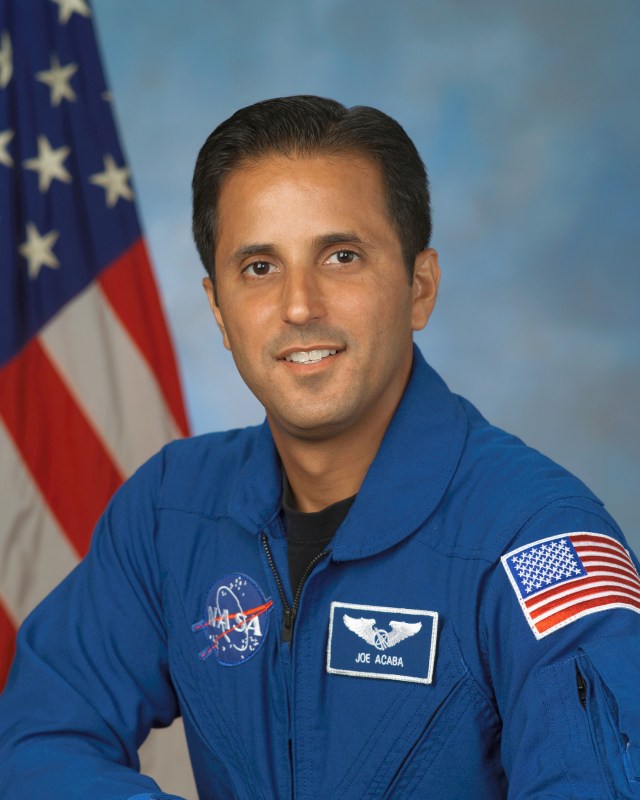
Joseph M. Acaba NASA Astronaut
Follow Joe
Summary
Joseph M. Acaba was selected by NASA in 2004. The California native has logged a total of 306 days in space on three missions. In 2009, Acaba flew aboard STS-119 on the Space Shuttle Discovery to the International Space Station to deliver the final pair of power-generating solar array wings and a truss element. During this mission, he conducted two spacewalks. In 2012, Acaba flew aboard a Soyuz spacecraft to the space station where he worked as Flight Engineer for the Expedition 31/32. During this mission, the first commercial resupply spacecraft, SpaceX Dragon, arrived at the station. Acaba most recently served as Flight Engineer on the International Space Station for Expedition 53/54.
Personal Data
Born in 1967 in Inglewood, California, and raised in Anaheim, California, where his parents, Ralph and Elsie, still reside. Enjoys outdoor activities, such as camping, hiking, biking, kayaking and scuba diving.
Education
Esperanza High School, Anaheim, California, 1985; Bachelor of Science in Geology, University of California – Santa Barbara, 1990; Master of Science in Geology, University of Arizona, 1992; Master of Education, Curriculum and Instruction, Texas Tech University, 2015.
Experience
Acaba was a member of the United States Marine Corps, Reserves. He worked as a hydro-geologist in Los Angeles, California, primarily on Superfund sites, and was involved in the assessment and remediation of groundwater contaminants. He spent two years in the United States Peace Corps as an Environmental Education Awareness Promoter in the Dominican Republic. He was also the manager of the Caribbean Marine Research Center at Lee Stocking Island in the Exumas, Bahamas. Prior to arriving at NASA, he taught one year of high school science at Melbourne High School, Florida, and four years of middle school math and science at Dunnellon Middle School, Florida.
NASA Experience
Selected as a mission specialist by NASA in May 2004. In February 2006, he completed astronaut candidate training that included scientific and technical briefings, intensive instruction in shuttle and International Space Station systems, physiological training, T-38 flight training and water and wilderness survival training. Upon completion of his training, Acaba was assigned to the Hardware Integration Team in the Space Station Branch, working technical issues with European Space Agency (ESA) hardware. He was also a member of the Space Shuttle Branch, supporting shuttle launch and landing preparations at the Kennedy Space Center, Florida. Acaba served as the Branch Chief of the International Space Station Operations branch, which is responsible for mission preparation and on-orbit support of space station crews. Most recently, Acaba served as Director of Operations Russia in Star City supporting crew training in Soyuz and Russian Segment systems.
Spaceflight Experience
STS-119 (March 15 to March 28, 2009). This was the 125th shuttle flight, the 36th flight of Discovery and the 28th shuttle flight to the International Space Station. The primary objective of this flight was to deliver the final pair of power-generating solar array wings and truss element to the International Space Station. Acaba accumulated 12 hours and 57 minutes of Extravehicular Activity (EVA) in two spacewalks. STS-119 returned to land at the Kennedy Space Center, having traveled 202 orbits and 5.3 million statute miles in 12 days, 19 hours and 29 minutes.
Expedition 31/32 (May 15 through September 17, 2012). Acaba launched on May 15, 2012, from the Baikonur Cosmodrome in Kazakhstan. Gennady Padalka and Sergei Revin of the Russian Federal Space Agency and Acaba landed their Soyuz TMA-04M spacecraft in Kazakhstan on September 17, 2012. Acaba spent 123 days aboard the station as a Flight Engineer of the Expedition 31 and 32 crews. Acaba supported the arrival of the first commercial resupply spacecraft, SpaceX’s Dragon, in late May; and was prime robotic arm operator for the capture and release of the third Japanese cargo ship, HTV3. Acaba served as intra-vehicular crew member and robotic arm operator for two U.S.-based spacewalks, helping to restore a critical power unit and exchange a faulty camera on the station’s robotic arm. Acaba also participated in numerous scientific research experiments and performed regular maintenance and operational tasks aboard the orbiting complex.
Expedition 53/54 (September 13 through February 28, 2018). The crew launched from the Baikonur Cosmodrome aboard the Soyuz spacecraft. Acaba, who served as Flight Engineer, was joined by Astronaut Mark Vande Hei and Russian Cosmonaut Alexander Misurkin of Roscosmos. During the mission the crew marked the beginning of the first long-term increase in crew size on the U.S. segment, enabling NASA to double the time dedicated to research and achieve a record-setting week of research that surpassed 100 hours. Highlights from this research include investigations into the manufacturing of fiber optic filaments in microgravity, improving the accuracy of an implantable glucoses biosensor, and measuring the Sun’s energy input to Earth. Acaba completed one spacewalk to lubricate an end effector and install new cameras on the station’s arm and truss.
Acaba has logged a total of 306 days in space on three flights.
Organizations
National Science Teachers Association, Association of Space Explorers
Pronunciation
JO-sehf AH-kah-bah




























